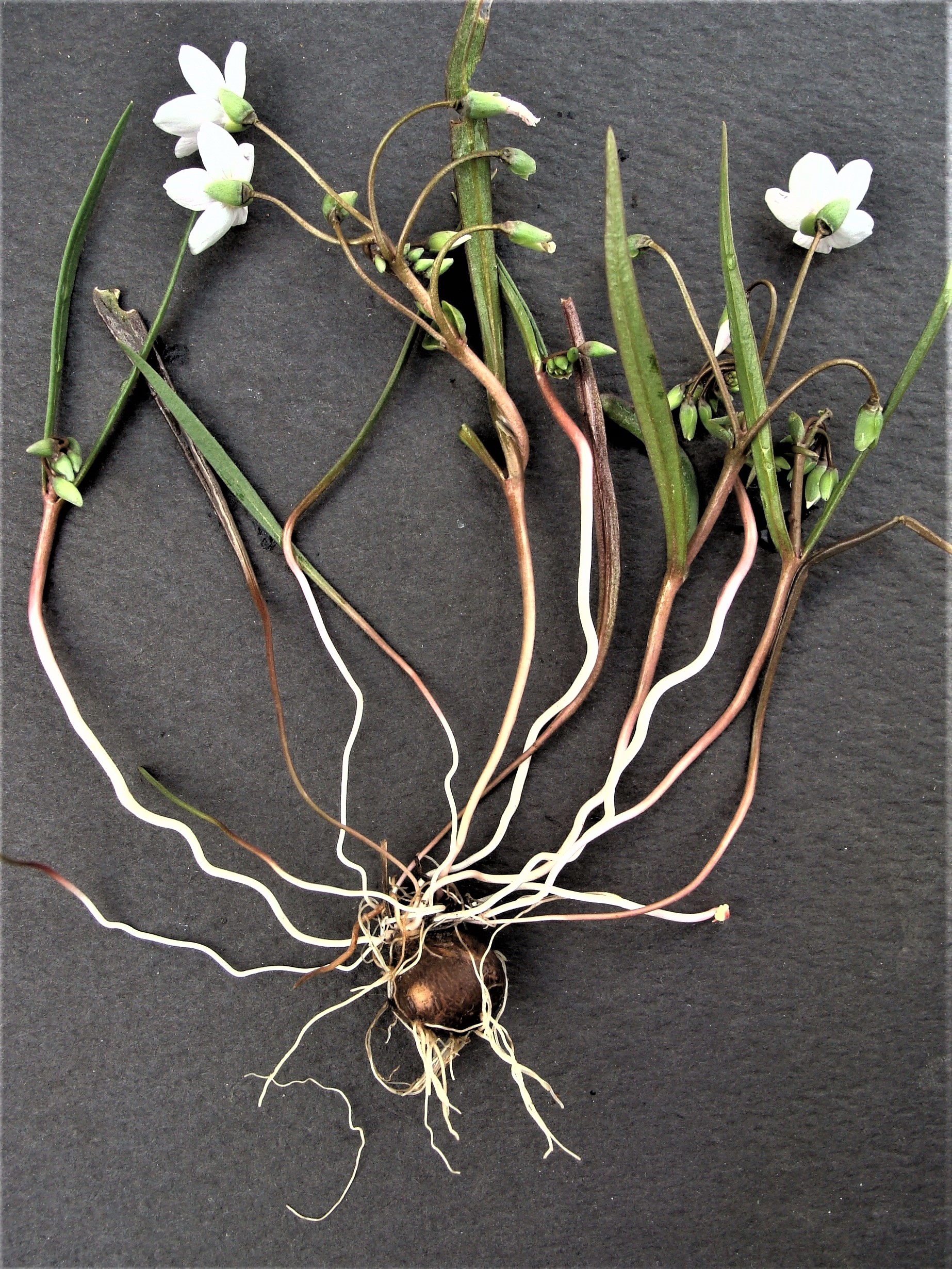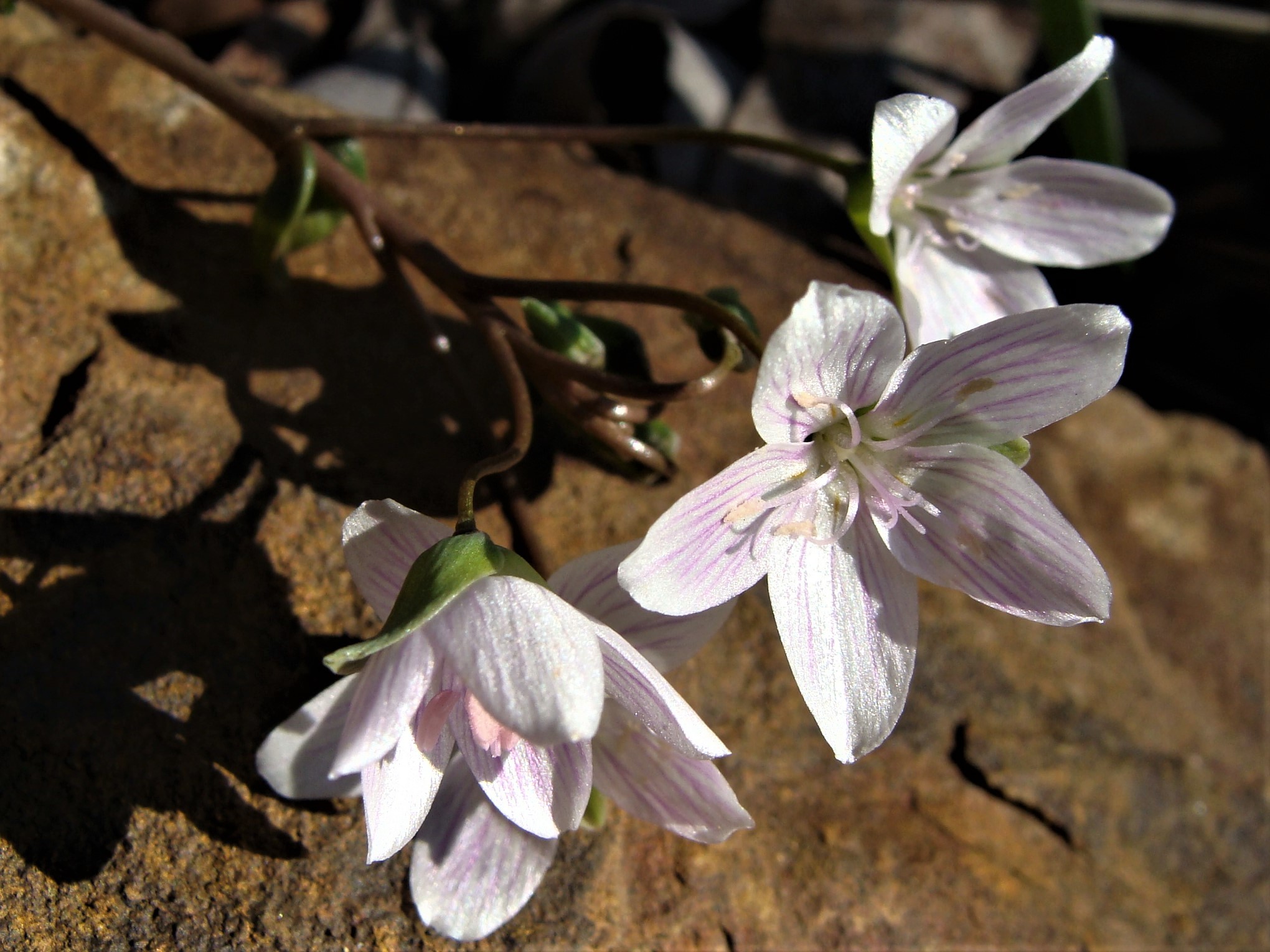Spring-beauty (Claytonia virginica), traditionally treated as a member of the Purslane (Portulacaceae) family but more recently as a member of the Miner’s-lettuce (Montiaceae) family, is a widespread, common, native wildflower, a perennial herb with lovely white, pink-veined flowers. The genus name honors John Clayton, one of Colonial America’s earliest botanists. The specific epithet refers to the state of Virginia, from where the specimen seen by Linnaeus, who described the species, was collected. In the U.S., spring beauty occurs from central Texas to Minnesota, east to New Hampshire and the Carolinas. In Arkansas, the species occurs statewide. Habitats are sunny to partly shady deciduous woodlands, prairies, and lawns. Other common names include Virginia spring-beauty, eastern spring-beauty, and fairy spud.
This low-growing, late winter to early spring ephemeral emerges from an ovoid to globose corm (a bulblike underground stem). Smaller corms are smooth and round; larger corms (to 2+ inches) tend to have bumpy irregular shapes. Smaller corms produce roots at their centers while larger corms have long ropy roots scattered across the entire lower surface. Similarly for vegetative growth, basal leaves and floral stems grow from centers of small corms but are concentrated at multiple “bumps” on the upper surface of large corms. New white ropy roots develop annually after vegetative growth is well advanced. Plants become dormant by mid-spring.

Seasonal growth begins in late fall with the appearance of glabrous, somewhat succulent, linear, basal leaves, to as long as 1 foot but only 1/16 inch wide. Leaves radiate from the corm along the ground. Distally, where the blades are exposed to sunlight, they are green (though sometimes reddish purple in winter when first emerging) and grass-like, tapering at both ends. Near the corm, where they are covered by living and decaying vegetation, the petioles are narrow and white. Except for the prominent midrib, leaf venation is obscure. Plants may spread to a diameter of several inches to 2 feet, the largest plants in full sun.
Flowering stems, also glabrous and rather succulent, emerge in early winter and bloom from March to April. Stems have two opposite, sessile, linear leaves (the cauline leaves) to 6 inches long and ¼ inch wide, similar to the grass-like portion of the basal leaves. Above the cauline leaf pair, stems extend directly into a raceme (sometimes more than one), with one or two small oval bracts at or immediately below the lowermost flower. Racemes comprise 8-20 flowers on long smooth pedicels alternating along the rachis; both pedicels and rachis may be reddish tinged. Flowers bloom sequentially from base to apex, with early, open flowers near the ground and uppermost flowers in a tight droopy cluster of small nodding buds. Plants may bear flowers in bloom for 1-2 months. As flowering stems continue to grow, they become semi-erect to 6+ inches long in fruit.



The sun-facing flowers, on slender pedicels, have 2 sepals, 5 petals, 5 stamens, and 1 pistil. The slightly overlapped sepals, positioned like a pair of hands, are a pale green with entire margins. The oval petals, also slightly overlapping, are broadest in the middle, with a rounded apex. Petals may be white to pinkish, with major veins variously highlighted in pink. Stamens and anthers also vary from white to pink. Filaments are broadened below, where they closely surround the pistil. During the first day of anthesis, stamens are erect as the light to dark pink pollen is shed; then, as anthers shrink, filaments recurve away from an erect central style. The style is topped by a slim stigma which, after pollen has been shed, divides to expose three stigmatic surfaces. The rain-drop-shaped, 1-chambered, superior ovary is mostly hidden by the lower, flatter portion of the filaments. Flowers, about 1/3 inch across, reclose at night and on cloudy days.




Fruits, 1-chambered, ovoid, peaked capsules, develop all along the fully extended racemes. Capsules split along 3 seams to release smooth shiny black seeds. The round slightly flattened seeds are from 1/16 to 1/8 inch across. Seeds have elaiosomes (fleshy external appendages) which facilitate dispersal by ants. Sepals remain persistent as seeds are dispersed and the plant goes dormant.

Spring beauty is a dependable and showy early spring flower. With its tendency to self-seed, it forms loose to dense colonies. In a garden, it may be welcomed or despised, depending on the gardener’s interests. Once established, removal of corms may be difficult, and spring beauty plants may be difficult to remove without damaging other desired plants. It provides a pleasing appearance in a woodland and can form a beautiful late winter/early spring floral blanket in a lawn. Flowers provide early spring nectar and pollen to various insects, and corms are eaten by small mammals. All parts of the plant are edible by humans, including the corms which may be cooked (basis for common name “fairy spud”) or used in salads.

Only one other native species of spring-beauty is known for certain in Arkansas, Arkansas spring-beauty (Claytonia arkansana), described as a new species in 2013 (www.phytoneuron.net/2013Phytoneuron/50PhytoN-Claytonia.pdf). It has rather spoon-shaped leaves, a bract subtending each flower, and is only know from crevices and ledges of sandstone bluffs in three central-Arkansas counties. Between 2006 and 2013, this plant had been called Ozark spring-beauty (Claytonia ozarkensis); however, there was a problem with the application of that name when it was described, necessitating the new name. Prior to that yet, these plants were lumped with what were later determined to be broad-leaved forms of Claytonia virginica, called forma robusta, and mis-identified as Carolina spring-beauty (Claytonia caroliniana), a more eastern species. Besides the two native perennial species of Claytonia in Arkansas, a presumed introduced population of miner’s-lettuce (Claytonia perfoliata), a western annual species, was discovered in a natural area in the state in 2019. This species looks very different from our native species, with rounded, often perfoliate cauline leaves.
Article and photographs by ANPS member Sid Vogelpohl

